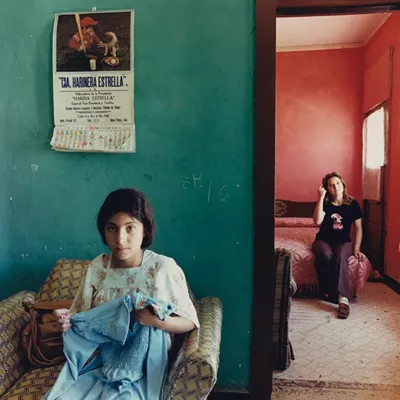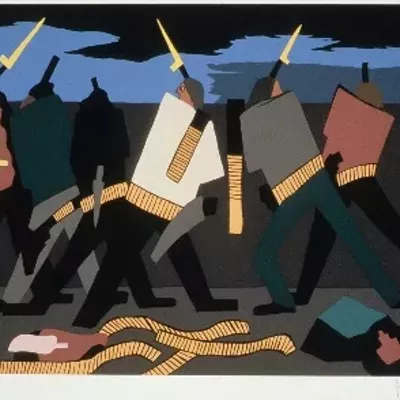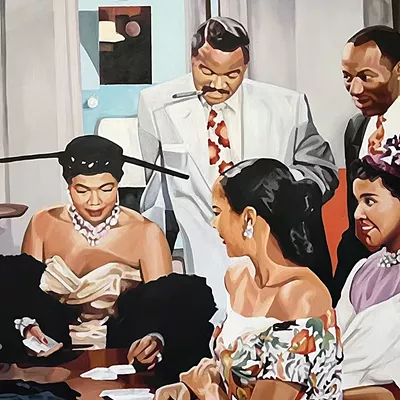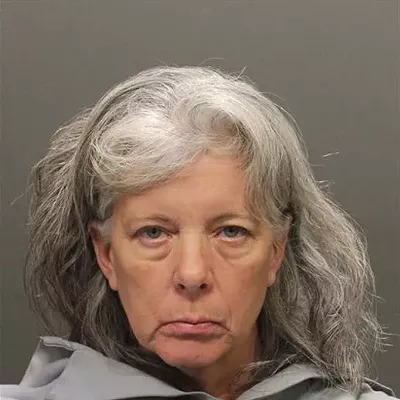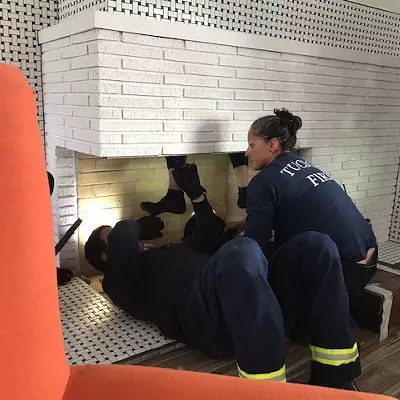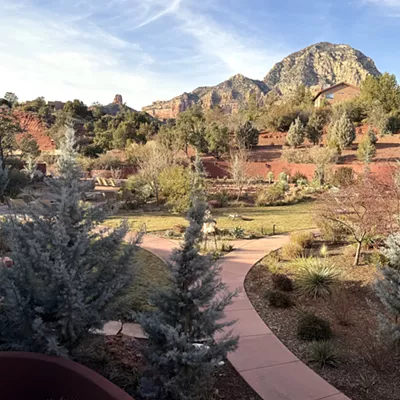In the prickly desert outside, mesquite thorns rip open the skin of migrants running from La Migra, mosquitoes torment them and rocks trip them up, but here inside the office it's all no-nonsense metal and concrete. Agents wander casually by in their dark green pants and shirts, guns and radios strapped to their black belts. These guys are used to seeing undocumented migrants--about 600 are picked up every single day in Douglas and Naco during the slow summer season--and they've long since grown accustomed to the tragic tales that the migrants have to tell.
But it's all new to Vasquez, a 32-year-old Guatemalan campesino. He's neatly dressed in American-style clothes--polo shirt, beige pants, baseball cap and tooled cowboy boots--but this place is worlds apart from his tiny village, San Francisco La Union. A K'iche' Maya pueblo 3,070 feet up in the forested highlands of western Guatemala, about 10 miles from Quetzaltenango, his town is a place where even Spanish is considered a foreign tongue.
At least Vasquez is being held in a regular room this evening, unlike the last hour's yield of undocumented Mexicans. Most captured Mexicans waive their right to a hearing before an immigration judge, and for the short hour they're at headquarters before they're "voluntarily" deported, they're herded into big cells. Looking worn and dusty from their time outside, they sit on benches together, drinking water. Metal sheeting covers three walls of their cells; instead of bars the fourth wall has cyclone fencing. Agents and captives alike have a casual air about the proceedings. Many of the Mexicans have been captured before, and they know the routine: They're fingerprinted and photographed, their data is entered into a computer, and then they're released. Most of them will be bused back to the border any minute, free to try the crossing again.
There's no chance Vasquez will be released any time soon. As a Guatemalan, he faces transport to an Immigration and Naturalization "processing center" in Florence, and a subsequent hearing before an immigration judge. It could be 20 or 30 days before he's deported back to his home country.
He hasn't yet heard this bad news, but the day's sorrowful events have already been plenty bad enough. Vasquez speaks quietly in Spanish and he looks down dejectedly at his hands as he talks. His surrender to the Border Patrol is not just a personal disaster. His family's future depended on the success of this trip. Back home he has a wife and four children, ages 1, 3, 5 and 8, and he had hoped to rescue them from poverty with the big wages he'd send back from the U.S.
"I just wanted to get to the United States," he tells us, Tucson Weekly photographer Héctor Acuña translating his words into English. "Maybe to Los Angeles."
At home, he says, he and his family farm "to eat. There's just not enough money."
No one from his village had ever made the treacherous trip to the U.S. before that he can remember, he says, but as a father he didn't see that he had a choice. He had to go, despite the rigors of the journey and the separation from his family. He's used to hard times. When Vasquez was an 8-year-old back in 1976, his country was ravaged by an earthquake. El terremoto was a natural disaster, no one's fault, but it was followed in the 1980s by a vicious human-made disaster. The government waged a bloody counter-insurgency campaign against its own people, leaving more than 100,000 dead or disappeared. There is no more war in Guatemala, Vasquez maintains, but there's no money either.
VASQUEZ MADE HIS great journey by bus. He wended his way out of Guatemala, northwest through Chiapas state, through central Mexico and eventually on into Sonora and the rag-tag border town of Agua Prieta. The trip, 2,750 miles long, took 25 days. On the road, like other traveling migrants, he was vulnerable. Vasquez suffered no attacks but he says the Mexican police shook him down for money every chance they got.
Once in Agua Prieta, he and young Silverio, a fellow Guatemalan, found themselves in the midst of throngs trying to get across la frontera. Ray Borane, the mayor of Douglas, estimates that on any given day 2,000 to 3,000 people congregate in his sister city, making plans to hop the border. The Guatemalan pair found a smuggler who agreed to guide them across the fence and then through the Arizona desert; Vasquez says he had no idea of their final destination.
It seemed do-able. Migrants crossing at Douglas generally have a shorter trek through the desert than those who cross the dangerous Tohono O'Oodham reservation, where the nearest road is some 30 miles away. If all goes well, and their coyote (smuggler) and pollero (chicken wrangler or guide) fulfill their end of the bargain, Douglas crossers can get to a road and an arranged ride within about five miles.
Vasquez and Silverio set out to cross the line about 7 p.m. on Wednesday, July 19, in a group of about 25 people. Their first hurdle was the border fence. In the center of town, vertical iron bars painted ochre make up a fence that's meant, half-heartedly, to be attractive. The bars allow breezes to pass through and afford a cross-hatched view for the houses across the street.
Just beyond the central city, though, all attempts at aesthetics disappear. The fence is raggedy sheet metal, discarded military flats once used as landing pads in the Persian Gulf War. Beyond the sheet metal, in the countryside, small fenceposts strung with barbed wire mark the international line.
The Douglas fence wasn't the only military hardware to be negotiated by Vasquez, Silverio and company. All along the border atop high poles are high-intensity lights, cameras and infrared sensors; some miles out into the desert are Sky Towers equipped with more of the same. And every few hundred yards along the fence sits a Border Patrol agent in a big white Ford Explorer, eyes trained on the line.
This military deployment by a major superpower was nevertheless no match for a band of impoverished people motivated by survival. The migrants somehow managed to jump the fence undetected, then began the hike through rough desert terrain. There was a light cloud cover Wednesday evening, and even a sprinkling of rain, yet shortly after beginning their trek on el otro lado, the other side, Silverio began to fall ill.
"We were only out one hour and he started to feel bad," Vasquez remembers. "He was tired and we sat down to rest." The group immediately abandoned them, he reports, shaking his head. "I had no idea I'd be left." Survival-of-the-fittest is the typical coyote MO; the weak who can't keep up are abandoned. Luckily, Vasquez says, he had paid no money yet--the guide fee was strictly cash-on-delivery.
The two Guatemalans struggled along on their own, but by midday Thursday the heat and the monsoon humidity had grown unbearable. There was "mucho calor," Vasquez remembers, of an intensity unimaginable to men who had spent their lives in Guatemala's cool highlands. Eventually Silverio collapsed. Alone with a sick man in a foreign and hostile country, Vasquez hoisted Silverio onto his back and tried to make his way back to Mexico. But it was hopeless.
Silverio began to have "dolor de corazón," Vasquez says, clutching his own chest to demonstrate his friend's pain. And "dolor de brazos," he adds, gripping his arms. And then, finally, simply, he died.
VASQUEZ COULD HAVE left the young man in the dirt and gone on alone. Maybe he could have found his pollero and even managed to get past Phoenix, where the Border Patrol presence almost disappears. He didn't, though. He made the decision to report the death, even though it meant his own capture. Plus he was having some chest pains of his own.
Distraught and terrified, he trudged a mile out to Border Road, where ordinary Douglas people were out driving, going shopping, picking up the kids, oblivious to the drama in the tall grass nearby.
Vasquez didn't have long to wait for La Migra. Border Patrol vehicles are a constant on the roads around Douglas. On a typical 20-minute drive from Douglas to Bisbee, drivers can count up to seven Border Patrol Ford Explorers parked vigilantly at roadside or hurtling toward still another capture, and it's a rare drive that doesn't yield the sight of a migrant being frisked by the side of the road, an arrest underway.
The agents took Vasquez to the hospital, where he got IV treatment for dehydration, and six hours later appeared fit and healthy. There was no helping Silverio. His body was taken to the morgue in Sierra Vista.
An autopsy conducted by Dr. Guery Flores, Cochise County medical examiner, determined that he had been "a very healthy young man," says Flores' assistant, Janice L. Fields; he was a robust fellow with a "well-developed musculo-skeletal system." Had he not tried to cross the desert, he wouldn't have died. "The cause of death was exposure. It doesn't take any time at all in the desert."
The chest pains mimicking a heart attack are a common symptom of dehydration, Fields says. "Unfortunately, yes, we've had a lot of these (deaths). At this time of year they don't understand how dangerous it is. They've never walked a long distance in the desert. This is a death warrant."
Until the Wednesday after his death Silverio remained officially unidentified, an anonymous foreigner in cold storage at a funeral parlor in Douglas. That morning, July 26, Fields received a notarized letter typed in the office of the mayor of Santa Cruz Cajolá, a village near Vasquez's own. The letter explained that a local family was certifying that the body being held in faraway Douglas was that of their son, Silverio Huinil Vail, who had just turned 23 on June 20. An ID photo they sent of the young man matched up with the body the medical examiner had seen. His body having been brought in within an hour of his death, Fields says, "He was very identifiable."
The family apparently learned of their son's death via a phone call from a cousin who had been traveling with the group, Fields says. The stricken family called the Cochise County sheriff, and went to the mayor's office to put their relationship to their son in black and white. Their grief is compounded by financial catastrophe. Now, instead of receiving the young man's wages, the family will pay to have his body shipped back to his home in Guatemala for burial.
THE DEATH OF Silverio Huinil Vail was by no means rare. In fact, it's number 55 on the official Border Patrol death tally for this fiscal year in the Tucson Sector, which stretches 281 miles from the New Mexico border to the Yuma County line. The running count of people who perish in the desert begins each year on October 1. Most of this year's victims, like Huinil, died of exposure; nine were killed in accidents; two drowned. Five were ruled homicides, says spokesman Rob Daniels; most of those victims suffocated after being squeezed into vans by the coyotes.
Huinil's death wasn't the last, either. In fact, since July 20, the day he took his last breath in his friend's arms, three more migrants followed him into death. Two were found on Monday, July 24, one near Sasabe, the other in Organ Pipe Cactus National Monument. On Thursday, July 27, a man was found near Three Points, and his decomposed body suggested that death had occurred five to seven days earlier. The three new deaths push the toll up to 58 deaths in 40 weeks, averaging out to about three deaths every two weeks. With two months left to go, this year's total is already double the 29 deaths in the Tucson Sector in all of fiscal 1999. In 1995, there were 12.
Migrant deaths have become so commonplace along the border, reports Linda Morales, a social worker who lives in Naco, Arizona, that they "don't even make the headlines here."
And, indeed, one day after Huinil's death, the Douglas Dispatch ran a Page One story on the Border Patrol. The article never mentioned a Guatemalan dying in the desert north of town, though. Headlined "Bees attack Border Patrol agents," it detailed instead the misfortunes of a clutch of agents-in-training who'd accidentally encountered a swarm of Africanized bees.
If some border residents have grown inured to the toll, activists who oppose American border policy find it appalling. They argue that America is causing the deaths of desperate economic refugees by an enforcement policy that has pushed them into the treacherous Arizona deserts.
"INS (Immigration and Naturalization Service) strategy forces people into forbidding areas," maintains Lupe Castillo, a board member of the Coalición de Derechos Humanos (Arizona Border Rights Project) in Tucson and a professor of history at Pima College.
It's no secret that in recent years the Border Patrol clamped down on the border near San Diego and around El Paso, urban centers where the dangers of wilderness treks are virtually non-existent. With those popular crossing spots all but sealed off, migrants impelled by poverty at home have turned to more remote areas--like the Tohono O'odham reservation and the ranch country around Douglas and Naco.
Right now "the most active points in the country are at Douglas," says the Border Patrol's Daniels. "Obviously the Tucson Sector is the busiest sector in the nation."
David Aguilar, chief of the Tucson Sector, readily agrees that the strategy to contain San Diego and El Paso has been a big success--"We sealed the border in San Diego," he says proudly--but he reads the deaths differently. It's the smugglers, he says, the coyotes and polleros, despised by agents and activists alike, who callously lead unknowing migrants into danger, and abandon them when trouble hits. The story of Huinil, he notes, follows this precise pattern.
"Smugglers manage about 90 percent of the immigrants," Aguilar says. "They are using our communities as staging areas." Operation Safeguard, the name given to the recent beefed-up enforcement in Arizona, particularly in heavily trafficked Douglas, is "denying smugglers the use of our communities as staging areas."
Aguilar adds that the Border Patrol conducts many medical rescues of people like Vasquez, who might otherwise have joined his friend in death. In the same fiscal year that the 58 migrants died, agents rescued another 1,023 in medical distress. "These are all people that were saved," he stresses.
Still, his argument sidesteps the fact that America's future busboys and motel cleaners and chicken packers wouldn't be wandering the desert at the mercy of coyotes if the nation's border policy were different.
BORANE, THE OUTSPOKEN Douglas mayor, is one who believes it's time to change the conversation.
"This policy is not working," he says. "They're forcing people to go into the desert and lose their lives."
A popular Democrat who recently won re-election, Borane is critical of the Clinton administration's border policy.
"I'm dismayed with the way the administration is handling the situation," he says. "We're solely doing border enforcement. Our only option is more-more." And though he doesn't want to criticize the Border Patrol, he says he's seen the number of agents in his town increase geometrically in recent years: The Douglas station had 58 agents in 1994, 200 in 1998 and abpit 450 in 2000. "Absolutely, it's an occupied town. It's like a militarized zone."
Mayor Borane's gotten national attention for his proposal for a legalized guest worker program, one that he says would have to be better managed than the exploitative bracero program of 50 years ago. But he also believes that something needs to be done for the thousands of undocumented workers already here, workers whose precarious legal status keeps them in a permanent underclass. Unscrupulous employers can exploit their fear of deportation, and simply call the INS on a worker demanding better working conditions or wages.
The Border Patrol has no way of calculating how many migrants slip through their grasp, but their stats on captures are staggering. In the whole of fiscal year 1999, agents in the Tucson Sector made 380,293 apprehensions. This year, with two full months left to go, the number stands at 514,114, according to spokesman Daniels. (He says about 10 percent of these are women, though activists maintain as many as 30 percent of migrants are female.) The agency likes to think that those figures mostly reflect better enforcement. Some of the numbers do represent multiple attempted crossings--and arrests--of a single person, but the skyrocketing totals also speak to the increasing desperation of people in Latin countries pushing to get into the prosperous United States.
"I walk over to Agua Prieta and sit in the park or restaurants and just strike up a conversation (with people waiting to cross)," says the bilingual Borane, a Douglas native whose own grandfather was a Lebanese immigrant with "illegal" status his whole adult life. "They want to work. They want to send money to their families."
If there were no jobs for the migrants in the United States, they wouldn't be coming, says Castillo, of Derechos Humanos. She says that undocumented workers are heavily concentrated in the tourism industry, making beds in hotels and busing restaurant tables; they clean homes and offices as domestics and janitors; they join construction crews as laborers, pick fruit in orchards and crops in fields, and pack chickens in factories in the Southeast.
Isabel Garcia, a Tucson attorney who also volunteers with Derechos Humanos, argues that in a hot economy plagued by worker shortages, "We need their labor."
But the nation doesn't make it easy for them to get to those low-paying jobs. If they can get to the border, hop the fence, slip through a superpower's military arsenal, elude armed ranchers, drink enough water to outlast a desert trek, cough up enough money for a coyote, well, then, maybe they'll be rewarded with a job cleaning toilets in a motel. If they're really lucky, they might even get minimum wage.
Garcia puts it this way: "We say to them, 'Yes, come through this deadly obstacle course and we'll employ you.'"
IT'S EVENING IN Naco, time for migrants to cross the border. The town plaza is pure Mexico. White wrought-iron benches are arranged around a bandshell. A wheeled stand selling cold aguas frescas (drinks) and hot elotes (corn) is parked at the north end. Kids are chasing a friendly black dog everyone calls La Negra. There are few women about, but men are everywhere, dressed in the border-crossing uniform of dusty T-shirt, blue jeans and running shoes. They're sitting tensely on benches, on steps.
As the sun drops, the activity steps up. People stand and sling small backpacks over their shoulders, the same nylon backpacks American schoolkids use to carry their books. Inside are not notebooks or pencils, though; the cargo is maybe a sweatshirt and a paper prayer, all the worldly goods a migrant has.
Little groups start striding purposefully to the east, to the west, to the edges of town, as far from the watchful eyes of La Migra as possible. In one crowd walking at a fast clip toward the east, I count 13 people: a father with his 6-year-old daughter on his shoulders, a mother with a year-old baby in her arms, still another woman with a toddler by the hand. The rest are adults. How this group intends to pass both the Border Patrol gauntlet and the fierce desert I have no idea.
Gabriel Hernandez Cortez, a 24-year-old from Guanajuato in central Mexico, is watching. He's already been over four times, and four times he's been caught. He's not going back until he nails down a plan for a friend to pick him up on the other side. Once Hernandez got as far as four kilometers into the U.S., but La Migra caught him as he was scrambling through a barbed-wire fence. An agent dragged him back by his hair, he says, ripping open his leg in the process. He pulls up a pants leg, proffering the 12-inch scar on his calf as proof.
He shrugs off the injury. "I don't blame La Migra. They're just doing their jobs, enforcing the laws that come down from above."
Hernandez has been living in the open in the plaza for four months, sleeping on the hard paving in a blanket that he shares with his buddy, Juan Antonio Perez Hernandez, a 36-year-old from Chihuahua. But the pair is mismatched, Hernandez small and Perez tall, and the Guanajuatan jokingly shakes and shimmies to show how they play tug-of-war with the blanket at night. Perez can boast of 20 crossings and only six captures; he says La Migra has never hurt him.
The friends don't like the so-called Hospitality Houses of Naco: They're expensive and dangerous. For $5 you get the privilege of putting down your blanket on concrete, and you get no food. The night before, some other migrants tell us, they were robbed at gunpoint in the casa de huéspedas. But the plaza has its own dangers. Another migrant got angry at Hernandez the same night, and broke his skin with a sharp stick. The new wound festers alongside the barbed-wire scar.
"You never know who's going to be drunk," he says. The police occasionally lock up the troublemakers, or hit the migrants up for a mordita, he says, but mostly they leave them alone.
We invite Hernandez and Perez to take a taco in Naco at the taquería, an establishment of orange Formica tabletops and tinkly jukebox pop. The pair digs into some carne asada, gobbling up the condiments of onion and cucumber, laughing at their own hunger. They refuse a second helping, grandly explaining that they don't want to get used to too much food.
Gradually their life stories come out.
Perez has a wife and two children, ages 10 and 12, back home, but he has plans to join a sister living in Phoenix. He wants to work in construction.
Hernandez, an expansive guy of philosophical bent, also is married with two kids. He has his heart set on Salem, Oregon. Back in Guanajuato, he says, he was earning about $4 a day in construction. A fifth-grade dropout, he's been working since he was 11 or 12. One of five children of a cabdriver, the enterprising young Gabriel and his 15-year-old brother secretly started their own commercial enterprise.
"We decided to drop out of school and start a little business selling popsicles," he says in Spanish. "We did it on our own and kept it from our Papí. We gave the money to our mother. It was quite a while before our father found out. He finally realized there were no more school expenses. Papí said, 'Great. You can start buying your own shoes and clothes.'"
When he was 17 and she was 15, he ran away with his future wife, Carolina. They married a few years later and had two boys, Juan Pedro, now 4, and Carlos Ernesto, 2. A year ago little Carlos fell seriously ill and had to be hospitalized. Though the baby recovered, the crisis ruined the family financially. The bill, Hernandez says, came to about $650 and he had to sell everything they owned. Carolina and the kids moved back in with her parents, and he struck out for the border. It's not exactly by choice.
"If I could do anything, if I were president, I'd improve the quality of jobs in Mexico," he says. "I prefer to stay home. But the only way to make it is to come North." There's an imbalance, he says, in the relations between the U.S. and Mexico. "American are free to cross the border at will, but it doesn't work the other way around. They're friendly tourists here, but as soon as I cross the border it's a different story. I just want a very tiny slice of pie, poquitos dolares. I just want to work for a little bit of money."
He says he'd like a guest worker program that would allow him to come across safely and work in peace until he had enough money to change his family's fortunes. He's not unaware of the dangers of la frontera;. that's one reason he's here without his wife and little boys. "I prefer to do the suffering part on my own."
The armed Douglas ranchers have gotten plenty of publicity in Mexico, but Hernandez only scoffs: "I'm not afraid of anything. I'm going to be the Mexican Rambo." His quieter friend, Perez, is more matter of fact: "I'm afraid of getting shot."
None of us knows yet that a young Guatemalan will die in the desert tomorrow, but both men seem indifferent to warnings about the desert heat. Their concerns are more immediate.
"People don't have fear in them when they try to go across," Hernandez explains. "The deaths happen because the guides lie to them....I don't worry about it. You worry about the basic struggles. What will I eat for breakfast?"
Hernandez knows the United States has deployed a vast arsenal to catch him when he comes. He's not worried about that either.
"They can send out millions of Border Patrol agents, but Mexicans can still get across. I'm going to break their cameras with my slingshot."
EDMUNDO ERIK MONCAYO is one small part of the obstacle course Hernandez must negotiate. A Mexican-American man who grew up in El Paso, Moncayo has been holding the line at Douglas as a Border Patrol agent for the last five years. He's a supervisor, an agent and an information specialist, and one of his many jobs is escorting reporters who want to ride a Border Patrol shift.
In recent months, the international media have descended on Douglas, population 14,000, attracted not only by the record migrant deaths but also by the Wild West stories of armed ranchers like Roger Barnett, who've rounded up migrants they find walking across their lands. The BBC has been in town, and so has CCN, a Knight-Ridder reporter based in Mexico City, a trio of German magazine journalists, and assorted press from American dailies, newsmagazines and television.
Moncayo believes that some intensive outreach to the ranchers has helped dampen that particular brushfire.
"We have a unit patrolling the ranches, the Ranch Patrol," he explains. "Part of it is enforcement, part of it is liaison. We ask them, 'Are there problems?'"
Some community cleanups also have helped ease the ranchers' complaints of litter on their land, he says. Discarded plastic water bottles mark the migrants' trails all around Douglas; even a casual glance roadside will uncover dozens of empty bottles. The ranchers' cows will eat anything, Moncayo says, including unhealthful plastic. Fleeing migrants leave clothes behind, too: a yellow sweatshirt encrusted with dirt just this side of a border fence, a pair of brown knee socks there.
Moncayo is an expert on the military hardware and the military maneuvers that so upset activists and civil libertarians, the kind of military derring-do that has critic Lupe Castillo declaring, "We are using low-intensity warfare techniques along the border."
The Constitution, Moncayo jokes, has an "asterisk" for the border. The Border Patrol legally can enter anyone's property--but not buildings--without a warrant, and in their search for the people they call UDAs--undocumented aliens--they can set up checkpoints along the road, stopping all drivers without probable cause.
At headquarters, he shows off a bank of computer screens, each of them displaying images from the surveillance cameras the Border Patrol has erected all over town. And far out in the desert he takes us up into a Sky Tower, a sort of Big Brother Box-cum-amusement park ride. Its long pole bends in half at a giant elbow, gently bringing the little tower room to the ground. We step inside and ride it back up to the sky, the better to see the land around. An infrared camera on top transmits images to a computer screen inside. The pictures are in negative--dark scrub at night becomes light--and hot bodies show up brilliantly. On this particular day, only a cat, a deer and some jackrabbits, but no humans, can be seen making their way across the desert.
BUT AS KNOWLEDGEABLE as Moncayo is about the hardware the taxpayers have been buying for his remote border station, he's positively brilliant when it comes to old-fashioned tracking. In the afternoon, while he's patrolling town in his SUV, Héctor and me along for the ride, a call comes over the radio that a rancher has spotted 20 UDAs making their way across her property.
(The language for the people runs the gamut. At one end are the depersonalizing "UDAs" and "bodies" of the Border Patrol, and at the other, the more loaded "refugee" and the reverential "pilgrim," a term used by Tucson author and activist Demetria Martinez. In between is the more neutral "migrant.")
Moncayo bounces his Explorer expertly into a rough dirt road cutting through the ranch in question, confers with another agent who's about to set out on foot into the brush, and swings around to the east. He gets out and bends down to examine footprints in the dust. He's suddenly on hyper-alert.
"See these footprints?" he says excitedly. "You can see that they're fresh. They're different from the ones made this morning."
Then he's off into the high desert grass, intently following tracks that are barely distinguishable to a less practiced eye. And suddenly he's gone. He's in the brush, somewhere, but he's invisible, as if the world had swallowed him up. Later we learn he'd jumped soundlessly into a dry streambed that's sheltered by mesquite trees. He followed the tracks around the bend in the creek, and suddenly came upon no fewer than 23 migrants who'd just dropped their weary bones for a rest. The cry went out: "La Migra!" and everybody scattered into the desert, leaving behind sweatshirts, water, potato chips. Héctor and I, doing a little tracking of our own, come upon the discards minutes later. One man has lost a small leatherette case. Inside are a pair of eyeglasses, some stomach medicine and several printed prayers. An Oración a San Cristobal, patron saint of travelers, has been hand-sewn--by a wife? a mother?--into a paper cover.
Moncayo's chase through the prickly desert lasts almost two hours. He's running in the heat the whole time, along with a whole team of fellow agents he's summoned. These guys are fit, to be sure, but they catch only a dozen of the migrants. Nine get away, but there's another bonus. Deep in the field the agents happen upon three bales of dried-out marijuana, 131 pounds of it, apparently abandoned a week ago.
But all is not quiet on the ranch. On the way back to the Explorer, we notice that someone has stopped and taken a blue sweatshirt that had been left in the creek bed, and helped himself to the abandoned jugs of water.
It's a long day for Moncayo, and he's never anything less than unflappable. On into the evening he doesn't flinch when three sassy Mexican boys drop down over the fence and taunt him from across a ditch, shaking their hips provocatively and calling out "Fuck you." He stares them down silently, until they scamper back over the border, just as he noncommittally listens to the sad saga of Ismael and Silverio back at the office.
I ask him: "How do you deal with hearing these tragic stories?"
"Not to sound jaded," he sighs, "but I've heard the stories so often I can tell them before they do." The stories are always the same: I just want to work, I want to feed my kids, I'd rather stay home but I don't have a choice.
Moncayo's a native Spanish speaker, and his language skills helped him ace the Spanish requirement at the Border Patrol academy. And he grew up along the Texas border, where La Migra is part and parcel of song and folklore. What's it like, for a Mexican-American, to come to work every day and chase Mexicans through the brush? Working for La Migra?
"I used to get more of a reaction," he admits. "Not so much anymore. My mother was a little upset at first but I think she was more worried about my being in law enforcement than anything else. I'm just doing a job."
A JOB THAT shows no sign of ending anytime soon. The next day proves a busy one for the Border Patrol of the Tucson Sector. As Héctor and I drive out of town, we see still another roadside arrest. Three Explorers parked, one airplane circling overhead, three agents in the field. The fruit of this expensive military mission is one very sweaty, overweight Mexican man, a future busboy perhaps. His hands tied with plastic tubing, he politely says "buenas tardes" when he's brought to the vehicle and he quietly asks for water.
North of Tombstone, the Border Patrol strikes gold. A road construction project is stopping traffic in both directions on Route 80, which normally has no checkpoints. The coyotes are apparently unaware of this disconcerting development, and the agents are arresting their human cargo by the vanload. By 4 in the afternoon, 200 migrants have been pulled out of dangerously overloaded vans. We see one that has disgorged 23 people. As vacationers zoom by on the scenic road, the captured migrants huddle in the van's shadow, plastic tubing tying them to each other. They've already drunk up all the water the agent has with him. They'll have to wait to get to headquarters for more.
One of the prisoners has a little bit of the swagger of Gabriel Hernandez Cortez. He's got a big name, too, and he writes it in my notebook: Ronal Estuardo Donado. He's been walking in the desert two days to pick up his ride near Bisbee, he says. The van had been en route to Phoenix, and everybody was to pay $800 to the coyote upon arrival. Two hundred more people, he says, are waiting in the desert for rides right now.
And there will be more the next day, and the next. Some will die, some will be captured, and some will make it into America.
Estuardo grins in satisfaction. "There's thousands more waiting to come," he says.
Note: The Immigration and Naturalization Service lists its Guatemalan prisoner as Walter Vasquez Vasquez. However, the Guatemalan Consulate in Los Angeles confirms that his name is Ismael, the name he gave the Tucson Weekly.

